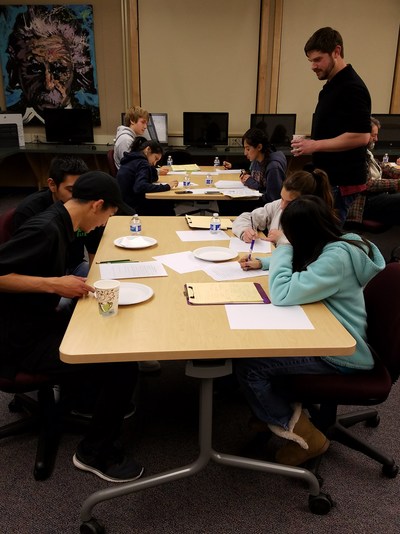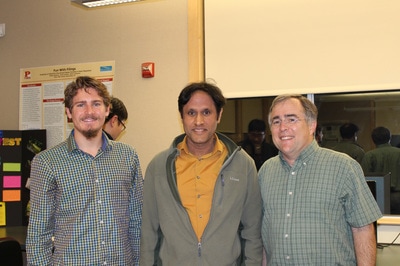
Everyone loves the Golden Gate and professional engineer Allan Tilton not only shared his passion and respect for this California icon, he brought in a working model of the bridge to help illustrate basics of bridge building. Mr. Tilton is a retired Civil Engineer and Traffic Engineer as well as a teacher for Community Ed classes on the history of engineering
The basics of bridges revolve around Form, Function and Structure, as we delighted to a visual feast of the variety of bridge types that exist ( or once did !). The focus of suspension bridges ranged from the squirrely rope bridge found across canyons in rainforests to the classics such as the Brooklyn Bridge. To demonstrate the dynamics of steel- volunteers both compressed and put tension on a steel rod- the former showing some buckling and the latter showing strength in tension- hence the reason we have massive towers on suspension bridges to support the delicate steel cables and framework.
Looking at the cables themselves we learned about Catenary curves that are classic in a main suspension cables and suspenders to hold up the stiffening trusses and bridge deck. The catenary curve created by free hanging chains or cables transformed to parabolic curves under loading. This was not always the way bridges were built as we reviewed some of the failures. Interestingly enough, many in the late 1800/s were caused by the weight not only of the men ( or horses) but the fact they keep the same cadence with their walk - an act now strictly forbidden and the rough step takes place when marking across a bridge) There was even a video of a Tacoma Narrows bridge in 1940 swaying from wind gusts of 40mph that caused such devastating undulation that the bridge collapsed ( all caught on black and white video !)
The history of the Brooklyn Bridge was brought alive and it was clear this is one of Allan's favorite bridges. He recounted the story of the Roebling family who engineered and built the bridge over a few generations. Most impressively was Emily Roebling who at first carried messages from her ailing husband to the crew and then over the course of 12 years educated herself in mathematics and engineering such that she became the lead on the project and first over during its celebratory opening. A side note- Mr. Roebling spent much of his time below the water in the caissons designed to keep water out of the underwater construction site and suffered from nitrogen narcosis ( originally called Caissons disease) which is what confined him to his home with only the use of a telescope to monitor bridge construction. We heard other stories about the corruption of the wire suppliers who would bring quality wire to the yard for initial inspection and then switch it out at night for a cheaper rendition- realizing this too late to change- the engineers added 150 more wires inside of each cable for extra support. An important concept in bridge building is just this and named redundancy. In the Brooklyn bridge there are 4 main cables, each attached by suspenders at two different places and in each cable are 19 bundles and in each bundle are 331 steel wires- connected to bars in anchor plates that are embedded in concrete. For our Golden Gate the same basic structure is true the question of why the bridge swayed during the 50th anniversary was because all of the people were in the middle of the bridge so it was a bit lower than the ends !
As we wrapped up with more pictures of amazing bridges around the world we started to rethink the bucket list and create a bridge list- especially to France to see this Cable Stay suspension bridge ! During the after cafe we created our own suspension bridges from cards and Kinex and had great fun putting to work the idea of belts and suspenders to hold up our creations. The Pined culinary class made delicious cupcakes complete with a miniature Golden gate on top and we feasted, as they did for the opening on another classic---the American Hot Dog !


























 RSS Feed
RSS Feed
